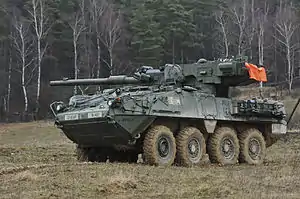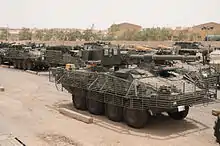M1128 Mobile Gun System
The M1128 Mobile Gun System is an eight-wheeled armored car of the Stryker armored fighting vehicle family, mounting a 105 mm tank gun, based on the Canadian LAV III light-armored vehicle manufactured by General Dynamics Land Systems. It is in service with the United States[5] and was also being considered for adoption by several other countries.
| M1128 Mobile Gun System | |
|---|---|
 A M1128 Mobile Gun System during a training exercise in 2015 | |
| Type | Assault gun Armored fighting vehicle |
| Place of origin | United States |
| Service history | |
| Wars | Iraq War [1] |
| Production history | |
| Manufacturer | General Dynamics Land Systems[2] |
| Produced | 2002–2010 |
| No. built | 142 [2] |
| Specifications | |
| Mass | 18.77 tonnes (20.69 short tons; 18.47 long tons) |
| Length | 6.95 m (22.92 ft) |
| Width | 2.72 m (8.97 ft) |
| Height | >2.64 m (>8.72 ft)[3] |
| Crew | 3 |
| Armor | 14.5 mm resistant[4] |
Main armament | M68A1E4 105 mm cannon |
Secondary armament | M2 .50 caliber machine gun; M240C coaxial machine gun; 2, M6 smoke grenade launchers |
| Engine | Caterpillar C7 turbo diesel 260 kW (350 hp) |
| Power/weight | 18.65 hp/ton |
| Transmission | Automatic 6 forward, 1 reverse |
| Suspension | 8×8 wheeled |
| Ground clearance | 15 in (38 cm) |
| Fuel capacity | 56 gallons (212 liters) |
Operational range | 330 miles (528 km) |
| Maximum speed | 60 mph (96 km/h) |
Design
Firepower

The MGS's low profile turret has a small silhouette, is stabilized and mounts a 105mm M68A1E4 rifled cannon with a muzzle brake and an autoloader. The vehicle is primarily outfitted to support infantry combat operations; while it could take on some of the roles of a tank, it is not designed to engage in combat with tanks. The MGS can store 18 rounds of main gun ammunition, 8 in the autoloader's carousel and an additional 10 in a replenisher located at the rear of the vehicle.[6] It has a rate of fire of ten rounds per minute.[7]
The MGS's 105 mm cannon can fire four types of ammunition: the M900 kinetic energy penetrator to destroy armored vehicles; the M456A2 high explosive anti-tank round to destroy thin-skinned vehicles and provide anti-personnel fragmentation; the M393A3 high explosive plastic round to destroy bunkers, machine gun and sniper positions, and create openings in walls for infantry to access; and M1040 canister shot for use against dismounted infantry in the open.[8][9]
Crew amenities
Because the vehicle was originally designed without air conditioning (A/C), crews were given cooling vests that circulate cooled water from outside the vehicle to the garment. Vehicle computers still overheated regularly. All MGS Stryker platforms have since been upgraded with A/C units.[10] The large weapon station and relatively smaller hatch can make emergency exits difficult.[1] Because the main cannon is separated from the crew compartment a gun stoppage during combat can only be cleared by disembarking from the vehicle.
Criticism
Shooting in motion from this vehicle seems to be very problematic, at least judging by the way the Stryker behaves when firing from a standstill. BMTV poorly "holds" the recoil of a full-fledged 105-mm tank gun, which has always been famous for its rather large muzzle energy. When fired, even in the longitudinal plane, the vehicle body falls heavily towards the stern. In addition, the high muzzle flames and the resulting significant shockwave require the infantry to stay away from the vehicle intended to support them. The military also criticized the too small ammunition load, as well as the difficulties that arise when the M1128 is airlifted. The fact is that the mass of the BMTV exceeds the carrying capacity of the C-130 aircraft, so you have to remove equipment, a set of screens, and sometimes even a cannon from the car.[11] The armor can be pierced by Soviet made RPG-7 projectiles.
Organization
The U.S. Army allocated nine Mobile Gun Systems to a battalion.[1] There were 27 Mobile Gun Systems per "Stryker brigade" in 2013, but later the Army cut the number per brigade to 10.[12] The Army bought 142 Mobile Gun Systems in total;[13] 3 were lost in combat. A three-vehicle MGS platoon operates organic to a Stryker infantry company, with one MGS in support of a Stryker infantry platoon.[14]
As of May 2017, a Stryker brigade combat team is equipped with three platoons of MGS Strykers and three platoons of ATGM Strykers in its weapons troop.[15]
History

Development
In course of the Armored Combat Vehicle Technology (ACVT) Program, both the U.S. Army and the Marine Corps have let separate fixed price vehicle design study contracts to nine contractors. The nine contractors were: Alvis Ltd, Cadillac Gage, General Motors of Canada, Pacific Car and Foundry, Bell Aerospace, FMC Corporation, Chrysler (jointly with General Dynamics), Teledyne and AAI Corporation. The gun, officially designated as the medium caliber anti-armor automatic cannon (MCAAAC), had been already developed by Ares Inc.[16] During development the original Ares Inc. made replenisher proved to be problematic and was replaced with one made by Meggitt Defense.[17]
Procurement
Following the end of the Cold War some theorists believed that the existing suite of U.S. armored vehicles, designed largely to fight Soviet mechanized forces in Europe, were not well suited to the lower-intensity missions U.S. armed forces would be tasked with. This led to the development of a new armored fighting vehicle designed for lower-intensity combat, rather than large-scale battle.
Canada had liquidated about half of its fleet of Leopard 1s in the early 2000s, with the intention of replacing them with the Mobile Gun System, but the decision was reversed.[18]
Full-rate production has been indefinitely deferred as of 2012.[19]
In late 2013, the U.S. Army began seeking to reintroduce an airdroppable mobile airborne protected firepower platform to provide fire support for air assault forces, a capability that had been absent since the retirement of the M551 Sheridan in 1997. General Dynamics initially considered modifying the wheeled Stryker MGS to meet the requirement,[12][20] but the company instead developed the tracked Griffin light tank technology demonstrator as its offering for the Mobile Protected Firepower (MPF) platform, which was unveiled in October 2016.[21]
See also
References
- Matthew Cox (4 February 2008). "Mobile Gun System brings the heat in Iraq". Gannett Government Media Corporation. Retrieved 28 August 2011.
- Green, Michael (22 Nov 2016). American Wheeled Armoured Fighting Vehicles. South Yorkshire, United Kingdom: Pen & Sword Books Ltd. p. 192. ISBN 1473854369. Retrieved 28 May 2020.
- "Equipment: Mobile Gun System vs. Leopard tank". cbc.ca.
- "Army Fact File – Stryker". Retrieved 2008-04-16.
- Soldiers train on Stryker gun system
- "Stryker mobile gun system replenisher". Meggitt Defense. Retrieved 30 July 2018.
- Ogg, David (2001-06-18). "The Road To The Objective Force "Armaments for the Army Transformation"" (PDF). Firepower Symposium: 32.
- M1128 Stryker Mobile Gun System - Globalsecurity.org
- "Archived copy" (PDF). Archived from the original (PDF) on 2014-08-26. Retrieved 2014-08-22.CS1 maint: archived copy as title (link)
- "PM (Preventive Maintenance) Keeps Strykers Combat Ready!" (PDF). Logistics Support Activity. Retrieved 30 July 2018.
- https://military.wikireading.ru/56499
- Matthew Cox (20 September 2013). "Army Looks to Mount 30mm Cannons on Strykers". Military.com. Retrieved 22 September 2013.
- Uparmored Bradley Could Be Tough Enough For AMPV: Testers - Breakingdefense.com, 29 January 2014
- Stryker Mobile Gun System (MGS) Archived 2014-10-19 at the Wayback Machine – Office of the Director, Operational Test & Evaluation. 2013
- "Stryker Brigade Combat Team Weapons Troop" (PDF). Army Publishing Directorate. Retrieved 30 July 2018.
- Department of Defense Appropriations for 1983, pt. 5, p. 791.
- Ayers, Christian. "The Stryker Mobile Gun System; A Case Study on Managing Complexity" (PDF). Defense Technical Information Center. Retrieved 30 July 2018.
- Major Howard Mark Anthony, Close Combat Vehicle and Leopard 2 Main Battle Tank: Back in the Heavyweight Fight, Canadian Forces College, pg 13, Footnote 21, https://www.cfc.forces.gc.ca/259/290/298/286/anthony.pdf Accessed 2019-11-17
- Brannen, Kate. "AUSA: U.S. Army Plans Post-War Management of Stryker Fleet." Defense News. February 23, 2012.
- U.S. Army in the Market for ‘Light’ Tanks Archived 2016-01-19 at the Wayback Machine - Nationaldefensemagazine.org, 7 October 2013
- General Dynamics presents new Griffin technology demonstrator of light tank for U.S. airborne troops - Armyrecognition.com, 5 October 2016
External links
![]() Media related to Stryker Mobile Gun System at Wikimedia Commons
Media related to Stryker Mobile Gun System at Wikimedia Commons

